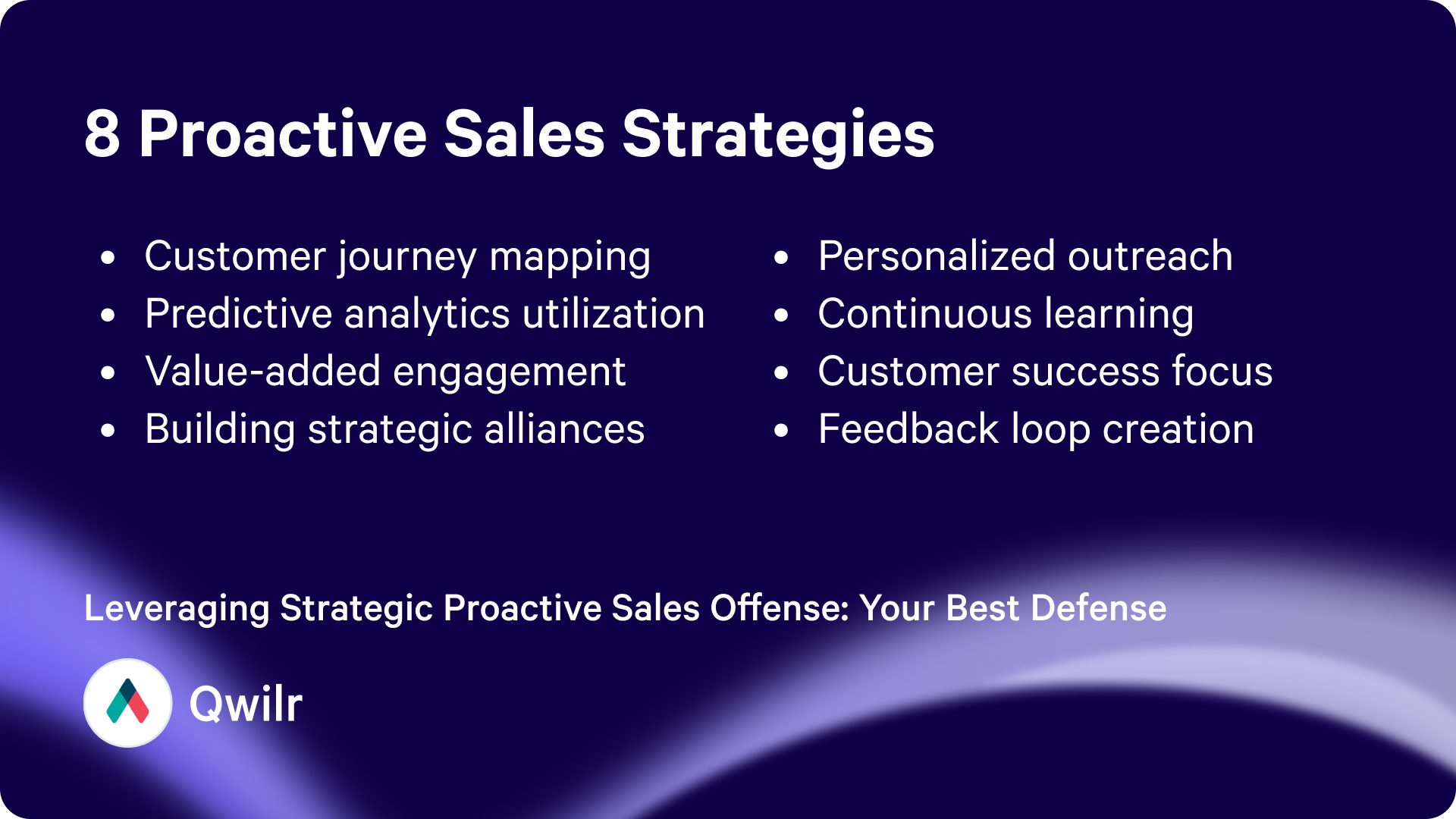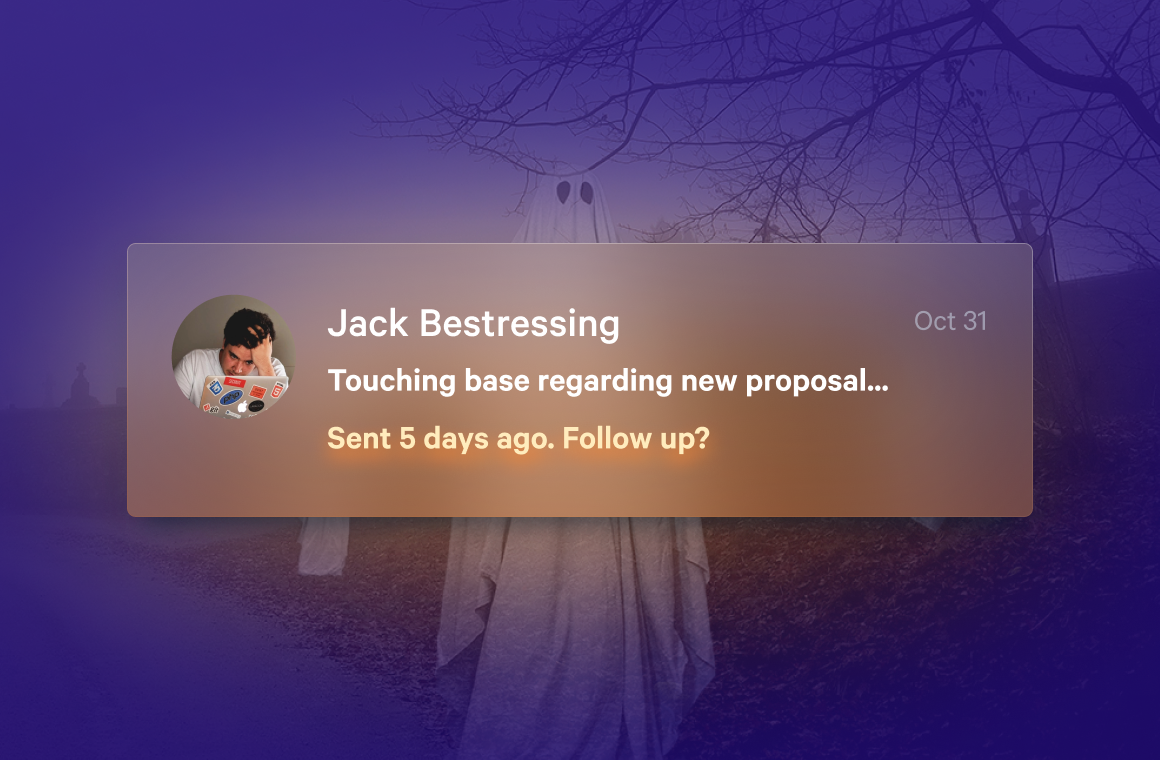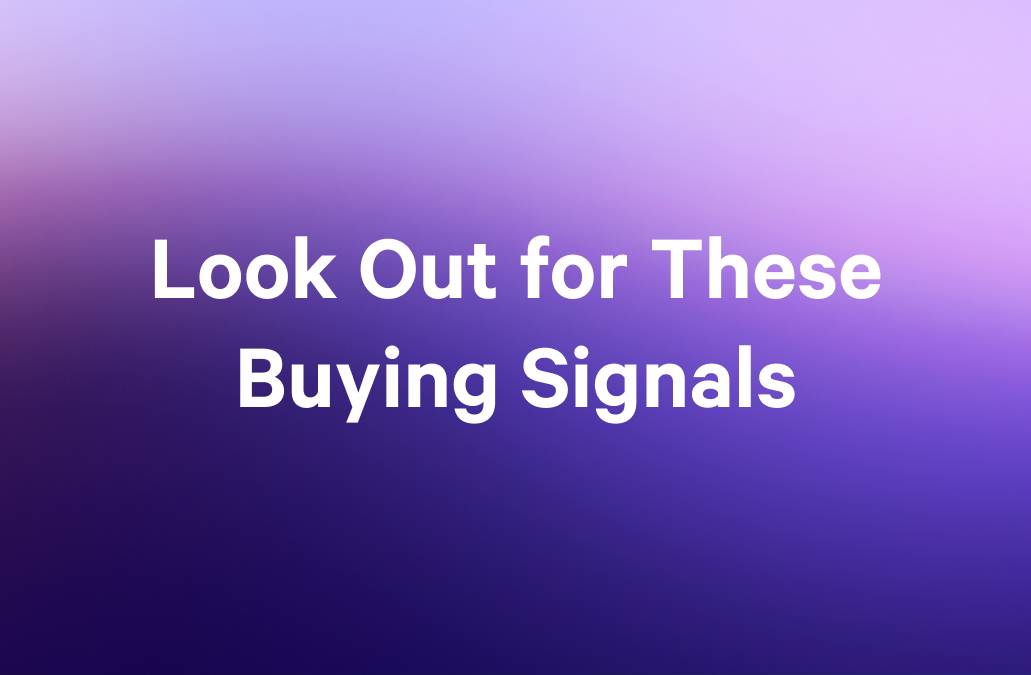Imagine kicking off the month not with anxiety over looming sales targets but with calm assurance that you’re ready to tackle whatever comes your way. That tranquility comes from a mastery of proactive sales, a concept familiar yet criminally underutilized in our high-stakes selling environment.
The issue many sales leaders face isn't rooted in a lack of effort but in an adherence to a reactive, somewhat defensive stance. We often find ourselves responding to, rather than preparing for, the opportunities and obstacles the market throws our way. But what if there was a way not just to anticipate these challenges but convert them into calculated steps toward our goals?
This article guides you in transcending the routine and the reactive in sales. It provides you with eight strategies that strip down the complexity of proactive sales into easily actionable insights that ensure your next move is always one step ahead.
What is proactive selling?
Proactive selling is all about taking the initiative. Instead of just responding to customer needs as they come up, it's about anticipating those needs and acting before they become urgent. Identifying potential customer’s opportunities or challenges before they're obvious, and setting things in motion early.
This sales methodology ensures you’re not just reacting to the market but actively steering your sales process based on foresight and preparation. Proactive selling gives you an advantage, allowing you to address customer needs before they even realize them and staying ahead of your competition.
What is the difference between proactive and reactive selling?
Proactive and reactive selling might seem similar, but they operate on different principles.
Proactive selling is like planting seeds for future harvest; it’s about strategizing and acting with foresight. Identifying opportunities and crafting a plan before a need arises. Setting the stage to guide customer decisions and take control of the sales process.
On the other hand, reactive sales is more like responding to weather changes; it revolves around responding to customer inquiries, needs, or problems as they occur, without previous planning or anticipation. Here, sales actions are primarily driven by external prompts rather than internal strategy, often making the approach more defensive and opportunistic.
While reactive selling answers the call, proactive selling ensures you make the call, paving a deliberate path toward your sales objectives.
Eight proactive sales strategies that all sales teams should use
Navigating through the world of sales successfully requires more than simply responding to the current market conditions and customer needs. It’s about adopting and embedding a strategy that is anticipative, strategic, and ahead of market fluctuations.
But these aren’t just sales techniques; they are philosophies that, when woven into your sales culture, enable your team not just to meet but actively shape and drive future market demands.
Let’s explore eight of the most effective proactive sales strategies.

1. Customer journey mapping
Customer journey mapping is about tracing your customers' footsteps through every stage of their buying process. This strategic tool is a porthole into their thoughts, decisions, and motivations- from the moment they discover your product to the post-purchase phase.
By understanding and analyzing each step, sales teams can uncover opportunities for sales reps to influence decisions, tailor communication, and enhance the buyer experience.
Essentially, it's about turning insights into action, letting your team position themselves to meet customer needs, often even before the customer identifies them, ensuring you’re not just responding to but guiding their journey.
2. Predictive analytics utilization
Predictive analytics in sales revolves around employing data, metrics, and algorithms to forecast future trends and customer behaviors. Leveraging historical data and market indicators, this approach enables sales teams to identify and predict future opportunities and challenges in the sales pipeline.
Instead of merely reacting to market changes, predictive analytics allows teams to strategize and operate based on informed predictions, ensuring actions and resources are strategically deployed. This enables your team to align effective sales strategies with data-driven insights, each move calculated and backed by a robust understanding of market patterns and customer behaviors.
3. Value-added engagement
Value-added sales engagement transcends traditional customer interactions by embedding genuine value into every communication. It’s not merely a token ‘check-in’ or a follow-up with your clients or prospective customers. Instead, it’s about enriching their experience and knowledge by providing meaningful content, insights, or assistance that is especially relevant to their unique needs and challenges. Sales teams can leverage generative AI in marketing to deliver personalized messages that align with customer needs while remaining mindful of both its benefits and potential drawbacks.
The objective for sales professionals here is to maintain a consistent and positive presence in their minds and cement your position as the trusted advisor modern buyers now look for, not just a supplier making a sales pitch. Your interactions move from transactional to transformational, nurturing a relationship where your value is recognized beyond the product or service you provide.
4. Building strategic alliances
“No man is an island,” nor should your business be.
A successful salesperson knows that sales never happens in a vacuum, and selling can take a team approach. This team approach may also extend outside of your sales organization. Savvy sellers work to build strategic alliances with other organizations in their industry or with sales reps who serve a similar segment of the market.
Building strategic alliances involves forging partnerships with entities, often outside your direct business domain, to create a mutually beneficial relationship. This kind of symbiotic relationship is where both entities augment each other’s capabilities, offerings, or market reach.
By aligning with businesses catering to a similar or complementary customer base, you unlock opportunities to tap into new segments, offer enhanced value to your existing customers, and possibly even create new offerings from the alliance. It's a collaboration where shared objectives pave the way for collective success, amplifying impact and reach.
5. Personalized outreach
This goes beyond just putting their first name on the email! It’s about diving deep into the CRM data, understanding each customer’s history, preferences, and challenges, and using this insight to initiate conversations that speak directly to them.
This transforms your interactions from generic to genuinely relevant, elevating your standing from a mere seller to a considerate advisor who ‘gets’ them. This personalized approach enhances the customer experience, significantly boosts the likelihood of conversion, and fosters enduring customer loyalty.
6. Continuous learning
Ensuring that your sales team remains at the peak of their performance involves more than mere practice; it demands continuous learning.
From leveraging the latest sales technologies to understanding emerging buyer and key decision-makers behaviors, continuous learning ensures your team keeps pace with the rapidly progressing world of sales.
Investing in regular sales training, workshops, and knowledge-sharing sessions ensures that your salesforce is not just meeting today’s benchmarks but setting tomorrow’s.
Training doesn’t have to be an event or a formal workshop; it can happen across the sales cycle or by observing and giving feedback on real-life sales calls with actual customers. In fact, offering the opportunity to debrief immediately after a sales call can give a sales rep the opportunity to be more proactive and make iterative changes to allow for continuous improvement.
7. Customer success focus
Embedding a customer success focus within your sales strategy means your engagement doesn't end once the deal is closed; rather, it blossoms into a journey where you consistently ensure the customer is extracting ongoing value from your product or service.
It’s about proactively engaging with them, understanding their usage, extracting feedback, and providing resources or assistance that enhance their experience and results.
Essentially, a customer success focus transforms your relationship from a one-off transaction to an ongoing partnership, ensuring customers see sustained value, which in turn nurtures loyalty, enhances satisfaction, and cultivates fertile ground for future sales and referrals.
8. Feedback loop creation
Embracing feedback loop creation in your sales strategy means actively seeking, analyzing, and acting upon customer input in a systematic and continuous manner. Systematic and continuous being the operative words here.
It requires you to build channels through which feedback flows consistently, ensuring the voice of the customer becomes a pivotal driver in shaping your offerings, strategies, and customer interactions.
This keeps your offerings perpetually refined and relevant to the evolving needs of your customers.
Companies that embody a proactive sales approach
A proactive sales approach is a strategy and an ethos that should pulse through every interaction and decision within a sales-driven company. Several organizations stand out with their implementation here.
Apple
Apple doesn’t just sell technology; it sells experiences. Often ones that consumers didn’t even realize they wanted! By continuously innovating and presenting new technologies and features, Apple doesn’t wait for customers to express a need; it anticipates or creates it. The release of each product is often in anticipation of emerging tech trends and consumer behaviors, ensuring they’re always a step ahead, both shaping and leading the market.
Amazon
Amazon leverages its vast repository of customer data to predict and influence buying behaviors. From personalized recommendations to strategically timed communication, Amazon uses predictive analytics not just to understand but also to anticipate customer needs, ensuring their offerings are consistently relevant and timely for each individual customer.
Salesforce
Salesforce, while providing CRM services, also practices what it preaches in terms of customer management and success. By consistently engaging customers with valuable content, insights, and new feature updates, Salesforce ensures its clients are continually deriving maximum value from their product while also being privy to the latest in CRM innovations and best practices.
Netflix
Netflix employs predictive analytics not just to recommend shows but also to inform its content creation strategy. Analyzing viewer habits, preferences, and viewing patterns, Netflix doesn’t just respond to trends but anticipates and shapes them, ensuring its content is both reflective and formative of viewer appetites.
Each of these companies demonstrates that a proactive sales approach is not about selling a product or service but about foreseeing, influencing, and crafting customer needs and experiences. It’s about moving from a seller to a valued partner, ensuring that every interaction is steeped in foresight, relevance, and strategic intent.
FAQ’s
How do you become a proactive salesperson?
Becoming a proactive salesperson involves cultivating a mindset that goes beyond merely responding to customer needs and instead, seeks to anticipate and shape them. It means embedding foresight, strategic thinking, and customer-centricity into every sales conversation, interaction, and decision.
Can proactive and reactive selling coexist in a sales strategy?
Absolutely! While proactive selling focuses on anticipating and shaping customer needs and behaviors, reactive selling, which responds to expressed customer needs, can still hold value in certain situations.
A balanced strategy might involve proactively engaging and guiding the customer through most of their journey and being adeptly responsive when unique, unanticipated pain points arise. It’s about being ahead of the curve, flexible, and responsive enough to navigate the unexpected.
What role does technology play in enhancing a proactive sales approach?
Technology is a vital enabler in amplifying and optimizing a proactive sales approach. CRM systems harness customer data to predict and influence future behaviors. AI and machine learning can uncover patterns and insights human analysts might overlook.
Communication technologies ensure timely and personalized outreach. Analytical tools provide nuanced insights into market trends. These all ensure that proactivity is instinctual, data-driven, strategic, and contextually relevant.
Bringing a proactive mindset into your sales organization
Embarking on a journey of proactive sales isn't just strategic – it's essential. In a constantly evolving landscape, staying one step ahead becomes our secret weapon. It’s about shifting from mere response to strategically foreseeing needs, paving the way for enhanced customer experiences and durable, impactful sales relationships.
Qwilr’s content and analytic solutions go hand in hand with the modern sales approach epitomized by proactive selling. Why not try it for free today alongside these eight strategies and see how far it can take you and your team members?
About the author

Marissa Taffer|Founder & President of M. Taffer Consulting
Marissa Taffer is the Founder & President of M. Taffer Consulting. She brings over 15 years of sales and marketing experience across various industries to a broad range of clients.


